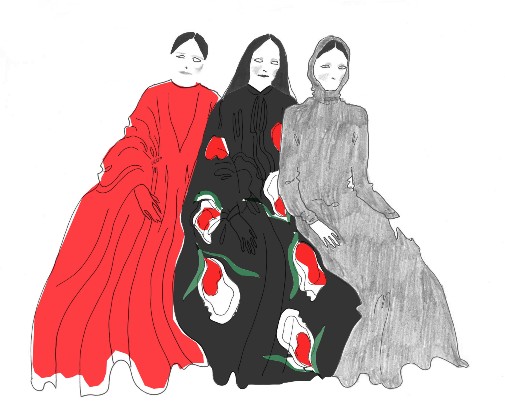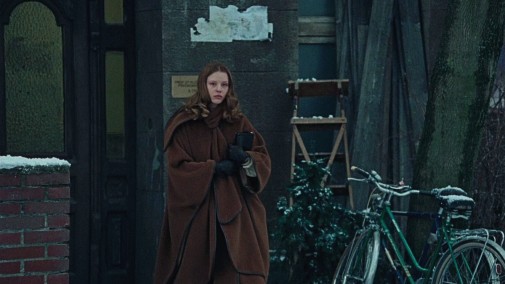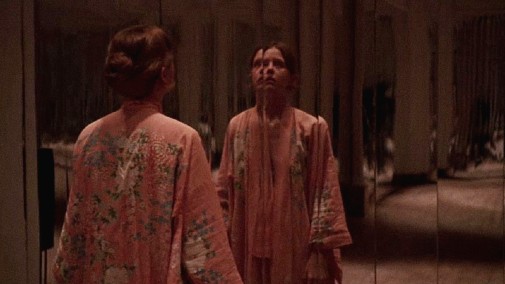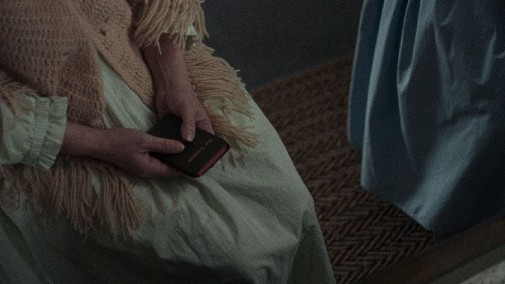Horror Costuming: Suspiria
 Tuesday, October 20, 2020 at 1:14PM
Tuesday, October 20, 2020 at 1:14PM A special miniseries for Halloween by Cláudio Alves
 Costume sketches by Giulia Piersanti
Costume sketches by Giulia Piersanti
As cinephiles, we're often too quick to condemn the idea of the remake. But remakes can often be illuminating. A good remake is a conversation made of echoes refracted through cinema and cultural history and time, as valuable, in its own way, as the original picture.
Luca Guadagnino's Suspiria is perhaps the supreme example of this. Instead of replicating Dario Argento's 1977 post-Giallo masterpiece, Guadagnino and his team have created an entirely new work that further explores themes only glanced at in the first movie. Even its look is excitingly different, autumnal and chilly where the previous film was carnivalesque and hot-blooded. One could write about the perfection of Sayombhu Mukdeeprom's cinematography or Inbal Weinberg's scenography, but, today, you're invited to reflect on the work of costume designer Giulia Piersanti…

The woman who Luca Guadagnino has described as "the most tasteful, thoughtful and ironic person I know" isn't a costumer by trade. Piersanti is a knitwear designer who was worked for such prestigious fashion houses as Balenciaga, Lanvin, and Dior. The first movie she ever worked in was Guadagnino's A Bigger Splash where, along with couturier Raf Simmons, she bedecked Tilda Swinton in elegant resort wear. Since then, she has costumed all of the director's narrative projects, except his short film The Staggering Girl.
Her work in the fashion business influences the way Piersanti approaches the task of costume design, the resources involved, especially when it's a period piece. Just like she did in Call Me By Your Name, Piersanti created Suspiria's wardrobe by deliberately avoiding the replication of recognizable period styles. Instead, she tries to find the connective tissue between the before and the now. Her vision of 1977 Berlin harkens back to the past, but the designs don't distract an eye accustomed to 21st-century styles. This also helps in the creation of idiosyncratic characters whose aesthetic denotes the individual instead of the bygone trend.

She took this ethos and further applied it to the relationship between this Suspiria and its old sister-mother. Despite being a fan of Argento's horror classic, Piersanti based the look of the new movie on other disparate influences. The lucid celluloid dreams of Rainer Werner Fassbinder were especially important in the development of this style, as were the pages of Sibylle, an East German answer to Vogue. The only person whose sartorial choices refer us to more mainstream and quasi-clichéd period references is Mia Goth's Sara. She's a sweet daughter of privilege whose posh outfits were partly inspired by Faye Dunaway in The Eyes of Laura Mars.

This methodology is anathema to the resource of pre-existing clothes. Because of that, Piersanti and her team created most of the film's costumes from scratch, only using some vintage pieces here and there. This allowed the designer to conceive a conceptual discourse that's transversal to all the costumes and is always present, even in the textiles. The intricate textures and subtle patterns of the fabrics invoke a world of female mysticism and brutality that only starts to reveal itself on the second, or third, or twenty-seventh time a viewer experiences Suspiria.

Guadagnino has pulled references from all sorts of places, sculpting an encyclopedia's worth of feminine artistry into his vision. The act of referencing isn't necessarily valuable, often coming off as pretentious. However, the way the director and his crew do it creates more conversations between art that complement the main dialogue of the deformed twins that are Suspiria '77 and Suspiria '18. New meanings are imbued into borrowed images, commenting on them, and creating ideas that blossom from the fertile ground of referential, reverential, homage. A mere mention of Ruth Bré shoots a cannonball of matriarchal ethos through the fabric of the movie, for example.
It's important to have that in consideration when looking at the costumes because, like everything else in Suspiria, they are often evoking other artworks and conversing with them. The custom-made textiles mentioned before are full of these references, often using the art of Louise Bourgeois as a prism through which to twist motifs that are traditionally associated with femininity. Notice, for instance, all the printed silk and cotton printed with seemingly innocent flowers. A closer look reveals that the florals are made of profiled faces, vivisected breasts, flowering vaginas, and, on one occasion, hip bones arranged to look like cherry blossoms. It's 70s women's fashion seen through a prism of transfigured, mutilated, biology.


These things are both horrifying and hauntingly seductive. The dance genius and powerful witch Madame Blanc may say that she wants to break the nose of every beautiful thing, but Piersanti sees value in aesthetic pleasure. Like the entirety of Suspiria, her costumes find beauty in brutality. Blanc is proof of that being part of a tryptic of evil whose three faces are embodied by Tilda Swinton. Madame Blanc is the insidious evil that hides and conquers others through enchantment. Mother Markos is the grotesque evil that shows itself for what it is, shocking and scary. As for Dr. Klemperer, he's the banality of evil, a nearly invisible malevolence that is born out of doing nothing when action is necessary.

Their costumes reflect those ideas perfectly. Blanc is as beautiful as the things she so wishes to reject, and her look is inspired by the mothers of modern dance and performance art – Bausch, Graham, Wigman, Abramovic. She's elegant but bound and defined by her work as an artist, her dark skirts dragging through the floor and making her look like a shadow of the Tanz Akademie that's gained sentience. Markos, on the other hand, is revoltingly ugly with her tyrant chic sunglasses and rotten body. Klemperer is a non-entity, a ghost of muddy brown wool that, like Chloë Grace Moretz's frenetic Patricia, often looks as if he's melting into the background.


Other characters, even minor ones, are as well-drawn as Swinton's three visages. The matrons of the Tanzgruppe, members of the witches' coven, are numerous but they're all neatly differentiated. Pay attention and you'll find other grand stories happening at the margins of this one, like that of Miss Griffith's fascinating fragility. With her mousy hair and oversized glasses, she looks like a skeletal rodent whose panic is so thick it can be tasted in the air. She's cowardice made flesh, someone who despondently casts a vote that she knows will bring about collective doom just because she doesn't dare to do otherwise. Her sickly costume illustrates that moral, ethical, and spiritual failing.






Then there's Vendergaast who moves around in loud graphic patterns, a caretaker for the Akademie's girls who's stuck in the midpoint between an aged femme fatale and a manipulative matriarch. Tanner is the witness that's kept alive so she can keep the memory of pain enshrined in her body and mind. The costumes she wears are dark and unassuming, the uniform of a caring servant who doesn't recognize the true evil of their master. In contrast, Miss Pavla is all giddy malevolence in cozy knitwear while Miss Millius is a statuesque vision of blind confidence in column-like ensembles. Balfour, in her scratchy cardigans, is the sister of all those butch matrons from prison-set B-movies of the 1950s, while Miss Huller is a harpy in fitted shirt-dresses that draw her figure in sharp lines.

I could go on, so specific are these side characters. Moving towards the center of the narrative, we have the aforementioned Sara and the protagonist, Susie Bannion. Poor Sara is a lamb destined for the slaughter from minute one and her costumes are constantly pointing towards her tragic condition as a cosmic victim. There're the flowers drawn from shredded flesh painting her pajamas, but also the jewelry that's all made of bone, the infantile blouses, and a dainty kimono. Most of these clothes, by the way, end up in Susie's possession as the story unfolds, an act of sisterly affection, lover's devotion, or something more sinister and vampiric.



Speaking of Susie, before we ever see our heroine, we're introduced to the world she comes from. In between the six acts and a prologue that compose Suspiria, flashes of a Mennonite community shine through the cracks in the nightmare - a desolate farm, its land barren brown, a ceiling of grey clouds above, and skeletal trees ravaging the horizon with claw-like branches. Inside the man-made building, we find clothes and pregnant young women attending to an older, dying matriarch. Their garments are tokens of religious rule in Easter pastels that have been bleached of cheer. The fabrics are worn but neatly pressed, taken care of. There's no wealth or savage creativity in this house, but there's the kind of motherly attention that makes a home, a womb.



From those loins of religious repression, Susie Bannion was born into this world, her body a vessel for something more terrifying than the deity her family worships. She arrives in Berlin with stolen money and dowdy clothes. Like everything else about her, these sartorial aspects mutate, changing along as her character reveals more inner depth, strength, and horror. Susie is the sin her mother smeared on the world, her attire growing to reflect that shame and portentous danger. She starts it all covered in denim and wool and ends it in borrowed clothes and a sheer dress, its deep cleavage perfect to show-off Susie's freshly opened chest vagina.

In the prelude to that bloody climax, Piersanti gets to parade some of her most daring creations. Inspired by the erotic photography of Nobuyoshi Araki and the Wedding Dress of Christo and Jeanne-Claude, the designer dressed the dancers of Volk (such a loaded word in German history) in bright red rope. The Shibari knots form pentagrams and other signals of witchcraft, entrapping the bodies while also creating the illusion of an unraveling organism. Because of their color, the swinging ropes almost look like dripping blood and viscera frozen in the shape of cord.
Red is an important symbol in Suspiria '18. Its muted palette makes the manifestation of ruby fleshiness all the more notable. Crimson is death, and only when Mother Suspiriorum summons Death herself, does the deep red of Argento consume Guadagnino's dream. In that scene, as the screen is dipped in the color of a torn body, the witches wear their Sabbath clothes, ritual garments made of human parts. Instead of skin and flesh, they are constructed out of hair woven through ribbon cages. Suspiria's costumes thus define a new type of body horror, one where the fear comes from the profane art that turns humans into raw material, wondrous witchcraft. It's frightening as much as it is dazzling.

Piersanti has remarked in interviews that "with remakes, it's the worst idea to take from the original. You have to make the extra effort to tell your own vision." Her work in Suspiria reflects that idea beautifully and it remains my favorite example of horror costuming in the 21st century. Ave Mater Suspiriorum!
previously: Kurt & Bart's work on Stoker



Reader Comments (9)
What a terrific analysis. Thank you, Claudio. Like the original, I will be rewatching Suspiria for years to come. So many critics and viewers just did not know what to make of it so they dismissed it. Which is a shame—it's such an endlessly fascinating, impeccably crafted film.
Yes, yes, yes!
I know it's sacrilege, but I much prefer the remake to the original for all the reasons in this post and more. Argento's version is a camp classic to me, but also a bit of a slog at barely 100 minutes.
I really enjoyed this assessment,it made we want to watch it right now,thanks,always interesting your posts.
I want to live in a world where Cláudio writes about my boring life in such a magical style. Always a pleasure to read you, especially about a movie that I like so much for the costume design. Pardon my english but, Cláudio, você é foda!
Oh yes indeed a beautiful article on such an amazing movie, my compliments , Claudio.
The ripples that Suspiria 2018 caused within the horror community are still being felt, and i guess the status of this Luca Guadagnino master class on re-imagining , and surpassing, an established, seemingly untouchable classic, will keep growing.
I do love this film as it's just bonkers but I had a hell of a time watching it. Yes, I prefer the Argento version but this is a rare remake that is equal to its original film.
Rob -- Thank you for the kind words. This one was difficult to write because I love SUSPIRIA so much and kept thinking my words weren't doing the picture justice. I too remember being dismayed at how so many wonderful critics and fellow cinephiles dismissed it. It's one thing to dislike what Guadagnino created but many seemed to just refuse to engage with the material. Apologies to the SUSPIRIA skeptics if I sound biased, but this is one of my favorite horror movies of recent vintage. In this regard, I may be a bit of a blind fanboy.
Working stiff -- While I adore Argento's movie too, I think I'm a fellow blasphemer since I too prefer Guadagnino's version. They're both incredibly valuable pieces of cinema, but the remake speaks more to me than the original, no matter how masterful it is.
markgordonuk -- Glad my words made you want to re-watch SUSPIRIA. That's an amazing compliment and you're very kind.
Antônio -- Muito obrigado, fico feliz que gostes do que eu escrevo. Por muito que ame os figurinos do BLACK PANTHER e A FAVORITA, tenho sempre dificuldade em decidir qual dos três, incluindo a minha amada SUSPIRIA, seria o meu vencedor do Óscar para Melhores Figurinos de 2018.
Toby Dammit -- I do have big hopes that Guadagnino's film will age well and perhaps conquer more deserved acclaim as the years go by. Btw, since we're talking about horror, let me tell you that I love your username. Did you choose it because of Fellini's short or maybe Poe's original tale? In either case, it's always delightful to see the name pop up in these comment sections.
thevoid99 -- Bonkers is a good way to describe it.
Thank you all for the feedback and your general kindness. It's much appreciated.
The costumes were impressive but the remake is still crap.
Beautiful analysis, Claudio. I'm not a fan of the film - I hate it's final act, it's bloated and I feel the film's protagonist is not who should be leading the story. However, there is much to admire about the film, specifically the costumes which you have so beautifully dissected.
I think the film is very reflective of styles of today, embodying elements of Alessandro Michele's work but through a "cold war" palette, which in some ways greatly speaks to our time.
I haven't revisited Suspiria since it came out but would definitely be curious to.